Should I Choose a Moissanite Engagement Ring?
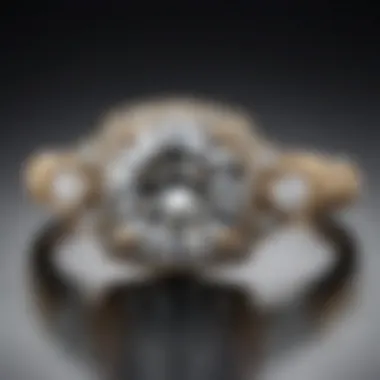
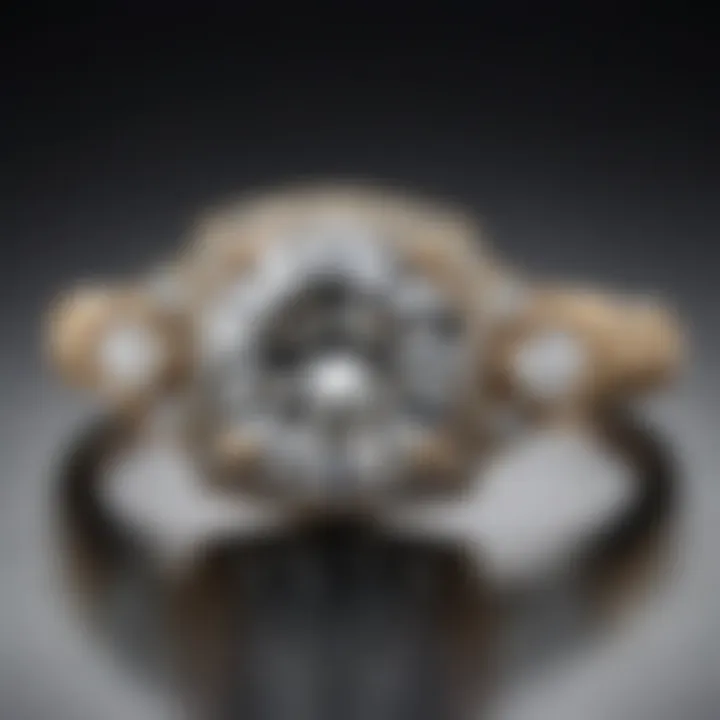
Intro
In the world of fine jewelry, engagement rings hold a unique position. They symbolize love, commitment, and promise. With the rising popularity of alternative gemstones, many find themselves asking if a moissanite engagement ring could be the perfect choice. This section aims to provide insights into the significant characteristics of moissanite, its comparison to traditional diamonds, and why it has increasingly captured the attention of couples seeking meaningful options.
Gemstone Overview
Definition and Characteristics
Moissanite, originally discovered in meteorites, boasts a brilliance that rivals the finest diamonds. Its origins trace back to 1893 when Henri Moissan identified it in a meteor crater. In its natural form, moissanite is extremely rare, but today, nearly all moissanite used in jewelry is lab-produced, ensuring both quality and consistency. With a refractive index greater than that of diamonds, moissanite displays fiery sparkle that can dazzle onlookers. The stone can appear to emit a colorful light, much more than what you might typically see from a diamond.
Classification of Gemstones
Gemstones are generally categorized into two main groups: precious and semi-precious stones. Precious stones include diamonds, rubies, sapphires, and emeralds, often regarded for their rarity and value. Moissanite, while not traditionally classified as precious, stands out due to its exquisite qualities and ethical production methods. As the market evolves, moissanite is gaining traction as a popular choice for engagement rings, blending beauty with conscious consumerism.
Properties of Gemstones
Physical Properties
Moissanite ranks 9.25 on the Mohs scale, making it extremely durable and resistant to scratching. This hardness ensures that the stone can withstand the rigors of daily wear, an essential feature for any engagement ring. Additionally, it's worth noting that moissanite exhibits a unique dual-refractive property, meaning it can sparkle and flare brightly under varied lighting conditions, adding to its allure.
Chemical Properties
Chemically, moissanite is silicon carbide, distinguishing it from diamond, which is purely carbon. This difference gives moissanite its distinct properties, including exceptional thermal conductivity and a lack of inclusions—features that often elevate its appeal among gemstone enthusiasts. Moreover, the lab-certified moissanite comes with guarantees of quality and ethical sourcing, providing buyers with peace of mind regarding their investment.
"Choosing the right gemstone is not just about aesthetics; it's about values and meanings that resonate with personal beliefs."
In summary, understanding the nuances of moissanite compared to traditional options is crucial. This comprehension will not only assist potential buyers in making informed decisions but also enrich their appreciation for what their engagement ring embodies.
Prelims to Moissanite
The conversation around engagement rings has shifted in recent years, drawing attention to alternatives like moissanite. This section sets the stage by underscoring why understanding moissanite is crucial for anyone pondering their engagement ring options. In a world where sustainability and personal expression are pivotal, knowing the ins and outs of moissanite can be a game-changer.
Moissanite has gained a reputation not just as a diamond substitute, but as a gem with unique merits. Shoppers today gravitate toward moissanite for multiple reasons—be it its brilliance, value, or ethical sourcing. It's essential to grasp its historical context and scientific properties, as these factors will guide potential buyers in making informed choices.
A moissanite ring sparks much chatter in both casual conversations and formal discussions. Potential buyers are often torn between the allure of diamonds and the various attributes of moissanite. Here, we break down what moissanite truly is, from its origin story to its chemical makeup, equipping readers with knowledge to navigate the sea of choices effectively.
History of Moissanite
Moissanite first saw the light of day in 1893 when scientist Henri Moissan discovered it in a meteorite crater in Arizona. The stone was a formidable surprise, as he initially mistook it for diamond. In fact, it took years for scientists to determine its true identity. Fast-forward to the late 20th century, and advances in technology allowed for the synthesis of moissanite in labs. This birthed a new era for gemstones, making them accessible, ethical, and affordable.
Since its commercial introduction in the 1990s, moissanite has steadily carved a niche for itself in the jewelry market. Social awareness about mining practices has pushed many consumers towards this lab-grown gem, enhancing its appeal.
"Moissanite is truly a modern marvel. It carries with it the weight of history and the promise of a sustainable future."
Chemical Composition and Characteristics
Diving into the nitty-gritty of moissanite means exploring its chemical composition. The chemical formula for moissanite is SiC, which means it comprises silicon and carbon. This unique structure contributes to its striking characteristics, notably its refractive index, which is higher than that of diamonds. Moissanite displays a fire and brilliance that can leave quite the impression.
- Color: Available in a range of shades, moissanite typically appears colorless or near-colorless. Although some stones may have yellow or gray hues, many jewelers focus on the colorless options for wedding rings.
- Brilliance: This is where moissanite shines—literally. The exceptional refractive index allows it to emit a light unlike any other gemstone. The way it reflects light can create a dazzling effect, making it a center-stage piece.
- Fire: Another captivating trait is its fire, which refers to the colorful flashes of light seen when the stone is rotated. These prismatic reflections often awe onlookers and set it apart from other gemstones.
Whether you're a jewelry designer or simply someone drawn to the aesthetic of engagement rings, learning about moissanite's characteristics is foundational. These properties not only inform buyers but also establish moissanite's position as a legitimate choice in engagement rings.
Comparing Moissanite to Diamonds
When it comes to engagement rings, there’s often a showdown between moissanite and diamonds. This section is crucial as it helps potential buyers navigate the complex decision of choosing the right stone. Quality, aesthetics, and long-term value consider all weigh heavily on your choices. Sifting through these elements enables someone to align a purchase with personal preferences and financial plans.
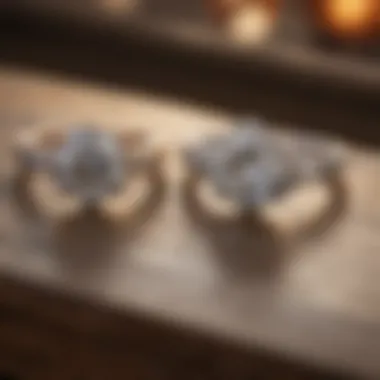

Visual Appearance
Color
The color of a moissanite stone can vary but is often assessed on a spectrum. It tends not to exhibit the yellower tones occasionally seen in some diamonds. A moissanite can sometimes have a slightly warmer glow to it, adding a unique charm—like catching a glimpse of sunlight through leaves. This distinctive quality makes moissanite a popular choice for those looking for a twist on tradition. Moissanite offers hues that can range from colorless to shades that are more visually surrounding, with shoppers typically leaning toward F and G colors. This feature can be an advantage for buyers who want a cleaner look without spending a fortune on a diamond with similar visual properties.
Brilliance
Brilliance plays a pivotal role in how a gemstone reflects light. A well-cut moissanite can have a higher refractive index than diamond, thus giving it an edge in sparkle. Imagine a summer night sky filled with stars—moissanite often achieves that extra twinkle due to its incredible light performance. For those who prioritize shine above all else, the brilliance of moissanite is definitely appealing. However, some might argue that this characteristic can sometimes create a 'disco ball' effect which isn't to everyone’s taste.
Fire
Fire refers to a gemstone's ability to separate light into shades of color, creating that dazzling display of rainbow refractions. Moissanite possesses a higher fire rating than diamonds, meaning you will likely notice its vivid flashes. This can be a highlight for people who adore a bit of color in their gems—akin to shooting stars in a clear sky. That said, while some find this to add character, others may prefer the more subdued fire of traditional diamonds, which may exhibit a subtler range of color interplay.
Durability and Hardness
Scratch Resistance
One popular factor is scratch resistance, pivotal for an engagement ring that gets daily wear. Being a material that ranks quite high on the Mohs scale, moissanite is resistant to scratches, making it a solid investment choice. It's not made of something delicate; rather, it stands up to everyday life much like a sturdy steel door. For couples who prefer less fuss and want their ring to maintain its luster over time, this can be a key advantage.
Wear and Tear
When it comes to general wear and tear, moissanite fares well for the long haul due to its hardness. It withstands the bumps and scrapes that life throws its way effectively; a little less worry for the wearer. Couples who lead active lifestyles might appreciate this resilient nature. Still, while durable, it’s worth noting that all gems can be damaged under the right circumstances. Thus, careful handling, though not overly complicated, should still be part of the routine.
Value Retention
Evaluating value retention can really up the ante for anyone in the market. Moissanites don't carry the same hefty price tag as diamonds, but many wonder if they hold their value similarly. Typically, moissanite experiences less rapid depreciation compared to diamonds, positioning them as a more financially astute choice—especially for budget-conscious buyers. In other words, one may find that their means stretch further without compromising beauty. In the world of gemstones, this can be quite a perk.
Ultimately, combining all these characteristics provides a multi-faceted understanding as to why moissanite continues to capture interest among those shopping for engagement rings. With such considerations, you move a step closer in making a decision that aligns with both style and substance.
Ethical Considerations
When looking at engagement rings, especially moissanite, you can't ignore the question of ethics. In a world where consumers are becoming increasingly aware of the origins of their purchases, especially in jewelry, ethical considerations come front and center. This section digs deep into two significant aspects: how these gemstones are sourced and the differences between lab-created and mined stones. These elements not only affect the environment but are crucial for aligning your purchase with your personal values.
Sourcing and Environmental Impact
The journey of a gemstone starts long before it finds a home on a finger. When discussing moissanite, one key benefit is its lesser impact on the planet compared to its diamond counterpart. Traditional diamond mining has sparked numerous environmental concerns. Large-scale excavations can lead to deforestation, habitat destruction, and significant carbon emissions.
On the flip side, moissanite, particularly the lab-grown type, has a much lighter ecological footprint. The synthetic production of moissanite takes place in highly controlled environments, minimizing the disruption to ecosystems. Moreover, these processes often consume less energy and put fewer resources at risk. This makes lab-created moissanite a more sustainable choice.
"If you're concerned with the environment, opting for moissanite helps ensure your ring won't cost the Earth."
Lab-Created vs. Mined Stones
One major talking point in the gem world today revolves around lab-created stones and their mined counterparts. Mined diamonds have long been the standard for engagement rings, but they come with a hefty baggage of ethical implications. Many mined diamonds are linked to war financing and labor exploitation, particularly in conflict zones.
Lab-created moissanite provides a refreshing alternative. Created in laboratories, they share physically identical properties to natural moissanite but come without the ethical gray areas. Switching to a lab-created option means supporting sustainable practices and weeding out the issues tied to traditional mining.
- Benefits of Lab-Created Moissanite:
- Considerations for Mined Stones:
- Produced in environmentally-safe conditions
- Eliminates exploitation risks associated with mining
- Offers a more accessible price point without sacrificing beauty
- Seek certification from reputable sources
- Understand the potential for negative social impact
- Recognize that some may view mined diamonds as more traditional or romantic
Choosing moissanite, particularly when it’s lab-created, allows you to make a statement about what you value. It's a decision that aligns the beauty of the ring with a commitment to responsible sourcing, reflecting both personal and environmental ethics.
Cost Analysis
Understanding the cost of an engagement ring is critical for many buyers, particularly when it comes to high-value items like moissanite or diamonds. In this section, we’ll explore the nuances of purchasing a moissanite engagement ring, touching on key factors such as pricing strategies and budgeting considerations. Knowing these details not only informs your choice but can also lead to significant savings on what is often a hefty purchase.
Price Comparison with Diamonds
One of the first things a potential buyer may do is compare prices between moissanite and diamonds. It’s like comparing apples to oranges, albeit both are fruits of the jewelry world. Moissanite is generally more affordable, often priced significantly lower than diamonds—often as much as 90% cheaper. This affordability allows buyers to consider larger or more elaborate stones without breaking the bank.
To break it down:
- A 1-carat diamond can range from $4,000 to $10,000 based on cut, clarity, and other factors.
- A comparable 1-carat moissanite, on the other hand, typically runs between $600 and $1,200.
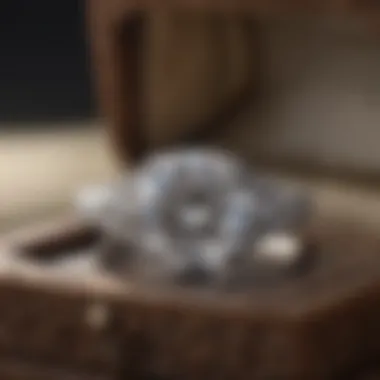
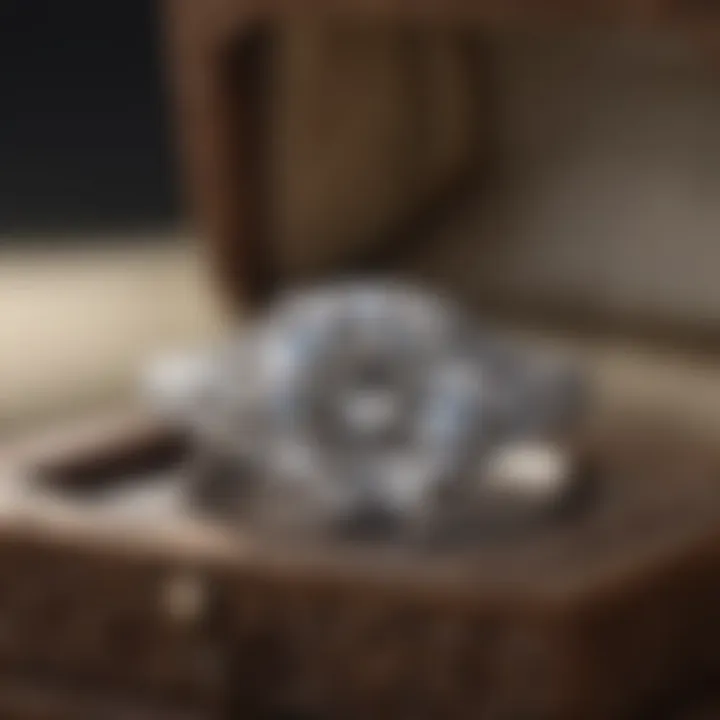
This stark price difference invites many to weigh the advantages of moissanite, not just in monetary terms but also in terms of potential savings for wedding expenses or future investments. That said, it's essential to also consider the resale value, as diamonds typically hold their value better than moissanites.
Budgeting for an Engagement Ring
When it comes to budgeting for an engagement ring, keep in mind that clarity of financial goals is essential. How much are you prepared to spend? Create a budget that feels both comfortable and realistic. It's important to remember that while traditional advice often suggests spending two or three months' salary on an engagement ring, the key lies in what fits your personal financial situation.
- Set a realistic budget: Assess your finances and identify what you can allocate to this purchase without straining your resources.
- Consider other costs: Don't forget to factor in additional expenses like settings, insurance, and future maintenance. Sometimes, what seems like an inexpensive stone could lead to costly settings or alterations later.
- Prioritize your values: If ethical sourcing and sustainability matter to you, weigh those values against the cost. Moissanite presents an ethically responsible choice without the price tag that often accompanies mined diamonds.
In sum, thoughtful cost analysis leads to informed purchasing decisions. The world of moissanite engagement rings offers a broad spectrum of options that can fulfill your desire for a beautiful ring while remaining mindful of your budget. It's not just about what the ring costs; it's about what it represents and how it fits into your life.
"Budgeting properly for an engagement ring can mean the difference between a beautiful stone and a financial headache down the line."
Ultimately, when considering an engagement ring, choose wisely. Don't let flashy marketing sway you from what's best for your situation.
Choosing the Right Moissanite
When searching for the perfect moissanite engagement ring, it's paramount to recognize that not all moissanites are created equal. Just like in life, the right choice often hinges upon a combination of personal values and aesthetic preferences. As you embark on this journey, it’s crucial to understand various factors that directly influence the final look and feel of the engagement ring.
These factors include the Cut, Color, and Clarity of the moissanite, each contributing uniquely to the stone's overall brilliance and charm. Furthermore, how the stone is set within the ring itself can dramatically enhance its appeal. We'll dive into the nitty-gritty details of these elements, guiding you to make an informed decision that resonates with your taste and wallet.
Factors to Consider
Cut
The cut of a moissanite is not simply about its shape but speaks to how well the stone reflects light. A well-cut moissanite can dazzle with brilliance, receiving optimum light and scattering it into a spectrum of colors. The most popular cuts include Round, Princess, and Cushion. Each cut has its unique character, with the Round cut often being the star of the show for its timeless appeal.
Choosing a superior cut enhances not only the appearance but also the joy of owning such a stunning gem. If the cut isn't right, even the most expensive stone can look lackluster, failing to capture light effectively. A round cut, for example, may often be seen as the benchmark, as it’s designed to maximize sparkle, making it a common choice. However, it’s wise to try and see these cuts in person, as they each exhibit different levels of brilliance.
Color
When it comes to color, moissanites typically range from near-colorless to faint shades of yellow or gray. The ideal choice often leans towards stones graded as G-H on the color scale, appearing nearly transparent and giving you that pristine diamond-like quality. Picking a stone too far down the scale can result in an undesirable tint, affecting the visual aesthetics.
A colorless moissanite can perfectly complement various metal choices without clashing. However, an additional unique characteristic of moissanite is its ability to retain a certain warmth. This quality adds a dreamy vibe to the stone when set within gold or rose gold bands, giving it a vintage appeal that many find enchanting.
Clarity
Clarity refers to the presence of internal or external flaws, known as inclusions and blemishes. Moissanites generally boast remarkable clarity levels, often graded as VS1 or VS2. The beauty of such clarity ensures that your ring sparkles in its full glory, unmarred by visible imperfections. Most observers can’t spot minor inclusions without professional-grade magnification, making this aspect less of a concern for many buyers.
Choosing a higher clarity can be a wise investment in the long run; however, that can also lead to increased costs. Balancing between clarity and your budget is essential, as some inclusions are virtually undetectable, allowing you to save some bucks without sacrificing aesthetics significantly.
Engagement Ring Settings
The way a moissanite stone is set can completely transform its overall impact. Two critical components here are the Metal Choices and the Design Styles that can make or break the look of your ring, so it's wise to put some thought into them.
Metal Choices
Common metal options include platinum, white gold, yellow gold, and rose gold, each presenting its own flair. Platinum, for one, has a natural luster and is highly durable, making it an ideal choice for settings that will be valued for a lifetime.
On the flip side, the warmth of yellow gold exudes a classic appeal that never goes out of style, often preferred for vintage-inspired rings. Each metal choice not only affects the visual appeal but also accommodates personal skin tones and lifestyle. For those with an active lifestyle, platinum or 14k gold may offer superior durability, resisting scrapes and scratches better than softer metals.
Design Styles
The design style of an engagement ring is where your personality truly shines through. Classic prong settings are popular for their timeless elegance, while bezel settings can enhance security for the stone, and add a contemporary twist to the ring. A halo setting can create an illusion of a larger center stone by surrounding the moissanite with smaller stones.
Ultimately, the right design should harmonize with the moissanite's sparkle and reflect the essence of the person wearing it. Whether you prefer something more traditional or a unique piece that stands out, the sky’s the limit when it comes to creative possibilities in engagement ring designs.
"Choosing a moissanite engagement ring can be a deeply personal decision rooted in your unique values and aesthetics. Whether it's the cut that dazzles, the gold that glows, or the clarity that speaks volumes, every factor plays a crucial role in crafting a piece of jewelry that tells your love story."
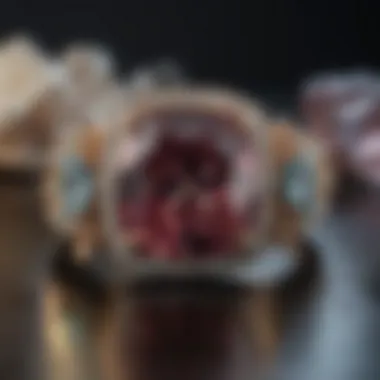
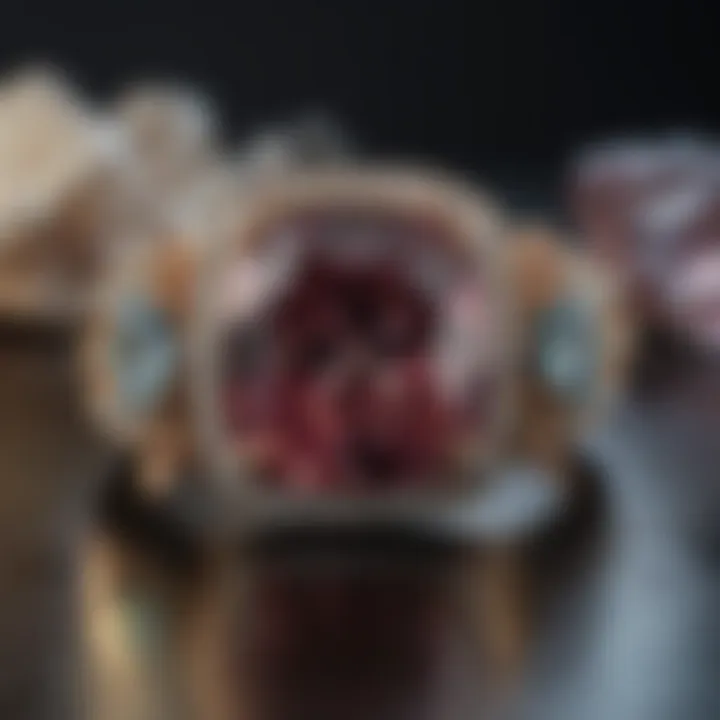
Gaining Insight from Experts
Navigating the waters of moissanite engagement rings can be quite a task. When considering such an important purchase, tapping into expertise can be a game changer. The significance of gaining insight from experts lies in their wealth of knowledge, which can enhance your understanding and assist in making a confident choice. This section delves into the ways expert advice can elevate your decision-making process.
Consulting Jewelers
Talking with jewelers can be invaluable. Their hands-on experience exposes them to countless gemstones and settings, thus allowing them to provide tailored recommendations that suit your specific preferences and budget. Jewelers can offer unique perspectives on:
- Quality Assessment: Understanding cut, color, and clarity varies from one jeweler to another. Jewelers expose you to different brands, ensuring you find the best for your money.
- Customization Options: Many jewelers offer stunning bespoke options that can be personalized just for you or your partner. This creates something truly unique and special.
- Maintenance Tips: Moissanites, while durable, have specific care needs, and jewelers can provide guidance on proper maintenance to keep your ring in top shape.
Engaging with a knowledgeable jeweler can empower you with essential knowledge you might have missed otherwise. But remember, finding someone you trust is key—there are some jewelers out there just after your wallet.
Online Reviews and Community Feedback
In this digital age, communities exist at every turn, and for gemstone enthusiasts, forums and social media platforms are treasure troves of information. Websites like Reddit or Facebook groups have dedicated spaces where buyers share their experiences. Here’s what makes digging into online reviews worthwhile:
- Real-Life Experiences: Hearing about experiences from actual customers can provide a clearer picture than any advertisement. You get a genuine idea of both satisfaction and potential pitfalls.
- Comparative Insights: Often, people will compare different brands and types of moissanite. Seeing these comparisons can help you weigh your options more effectively.
- Support Networks: Online communities can serve as great support systems for buyers, where you can ask questions and receive quick answers from passionate individuals who share your interests.
"The best knowledge comes from those who have walked the path before you. Listening to their advice can save you both money and heartache."
Personal Values and Brand Reputation
When faced with the question of purchasing a moissanite engagement ring, one cannot overlook the significant role of personal values and brand reputation. In today’s market, consumers are more conscious than ever about the impact of their choices, especially when it comes to luxury items like engagement rings. It goes beyond just aesthetics or price; it's about aligning one's purchase with their ethical stance and values.
Social Responsibility in Gemstone Buying
In the age of information, the social responsibility aspect of gemstone buying has gained heightened attention. Many individuals now seek to understand the origins of their gemstones and whether they have been sourced ethically. This is particularly relevant for engagement rings, which symbolize commitment and integrity.
Investing in a moissanite ring can often mean supporting more sustainable practices compared to traditional diamond mining, which has been marred by environmental degradation and humanitarian violations. Moissanite is typically lab-created, reducing the carbon footprint associated with mining. Opting for moissanite showcases a commitment to sustainability while still meeting the desires for beauty and brilliance in a gemstone.
Moreover, consumers should be aware of the broader implications of their purchases. Companies that adhere to ethical sourcing practices often showcase transparency in their operations, which can serve as a litmus test for their integrity. Engaging with brands that promote social responsibility can amplify the positive impact on the world, making the decision to purchase moissanite even more fulfilling.
Choosing Reputable Brands
Selecting a reputable brand is just as critical as choosing the stone itself. The market is flooded with companies offering moissanite rings, but not all are created equal. This is where due diligence comes into play. When looking for a brand, potential buyers should consider
- Transparency: Does the brand openly communicate its sourcing practices? A good brand will detail where its moissanite comes from and how it’s produced.
- Customer Reviews: Feedback from other buyers can be telling. A reputable brand will likely have a solid track record of customer satisfaction. Explore platforms like Reddit or Facebook for candid discussions on personal experiences with various brands.
- Certifications: Just as with diamonds, a certificate can provide information on a moissanite's quality. Check if the brand offers certificates from recognized organizations.
Reputable brands often build a reputation on quality, ethical practices, and customer service, allowing buyers to feel secure in their purchases. When consumers prioritize brand reputation alongside personal values, it can lead to informed choices that resonate on a deeper level.
"Your ring is a reflection of your love story; choose a brand that tells the story you want to share."
As engagement rings are not only a symbol of love but also an expression of personal beliefs, the consideration of personal values in conjunction with brand reputation can enhance the significance of the purchase. In a world where jewelry can embody ideals of sustainability and ethics, the choice of a moissanite engagement ring can stand as a testament to values that matter.
Final Thoughts
As this exploration into moissanite engagement rings comes to a close, it's crucial to reflect on the various aspects we've discussed. Understanding the nuances of moissanite compared to traditional diamonds is not just about choosing a stone; it’s about aligning your choice with personal values, budget, and aesthetic preferences. The rising awareness regarding ethical sourcing and the environmental implications of gemstone mining has made moissanite a compelling alternative. This overview serves as a reminder that your selection should resonate beyond the physical beauty of the ring—it should reflect your principles and desires.
Weighing the Benefits
When considering a moissanite engagement ring, it’s beneficial to run through the advantages it offers. Here are some key points:
- Cost-Effective Option: Compared to a natural diamond, moissanite rings typically cost significantly less. This affordability allows buyers to allocate funds toward other meaningful experiences or purchases.
- Ethical Considerations: With increasing focus on sustainability, lab-created gemstones like moissanite provide a guilt-free alternative. The reality is, they often involve less environmental disruption than mined stones.
- Durability: With a hardness rate of 9.25 on the Mohs scale, moissanite holds up quite well against scratches and daily wear. This quality ensures the stone lasts, maintaining its sparkle over the years.
- Unique Brilliance: Moissanite possesses double refraction, giving it a unique shine that can appear more luminous than some diamonds. This quirk can make your ring stand out in a crowd.
In balancing these positives against personal needs and desires, it becomes clearer why many opt for moissanite over its more traditional counterparts.
Making an Informed Decision
Deciding to purchase an engagement ring is a personal journey. Here are a few pointers to ensure that your choice reflects your priorities:
- Do Your Homework: Research various brands and their ethical practices. Dive into customer reviews to gauge satisfaction.
- Know what You Want: Reflect on what matters most to you—be it budget, sustainability, or aesthetic qualities. This will help streamline your choices and avoid confusion down the road.
- Consult Experts: Don’t shy away from visiting jewelers and discussing your options. They can offer insights tailored to your preferences and needs.
- Visualize: Imagine how the ring will fit into your lifestyle. Will it withstand your daily activities? Alongside your clothing style?
Remember, ultimately your ring symbolizes a significant commitment. An informed choice ensures that it aligns with your values and reflects the uniqueness of your relationship.



